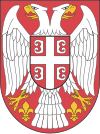Serbia in the Roman era
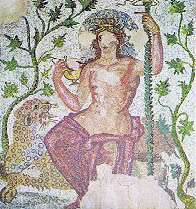
.jpg)
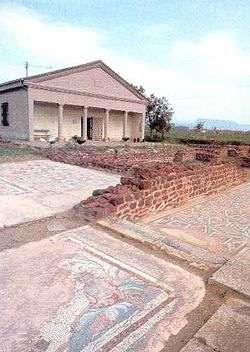
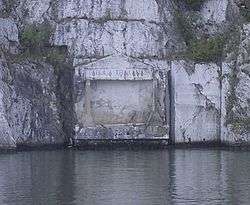

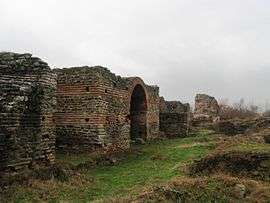
The territory of what is today the Republic of Serbia was under Roman (and later Byzantine) rule for about 600 years, from the 1st century BC until the Slavic invasions of the 6th century. It was administratively divided into Moesia (later Moesia Superior, corresponding to Serbia proper, Pannonia (later Pannonia Inferior) and Dardania (corresponding to eastern and western Serbia proper, respectively)).
The Danube River influenced the extension of the Roman Empire, and its confluents, such as Sava and Morava, affected the growth of frontier fortresses and towns, whose remains present the extent of the Roman Empire with architecture that presents the crown of Roman culture. Many authors and explorers wrote about traces of the Roman Empire on the Danube coast. One of the localities, Felix Romuliana, was ranked on the list of cultural heritage of UNESCO in July 2007.
The location has been invaded by many peoples over the centuries. The northern Serbian city of Sirmium (Sremska Mitrovica) was among the top 4 cities of the late Roman Empire, serving as its capital during the Tetrarchy.[1] Contemporary Serbia comprises the classical regions of Moesia, Pannonia, parts of Dalmatia, Dacia and Macedonia.
History
Roman conquest
The Roman Republic conquered the region of Illyria in 168 BC in the aftermath of the Illyrian Wars. "Illyria" was a designation of a roughly defined region of the western Balkans as seen from a Roman perspective, just as Magna Germania is a rough geographic term not delineated by any linguistic or ethnic unity. The later province of Illyricum was to the west of what is now Serbia.
The Romans conquered parts of Serbia in 167 BC and established the province of Illyricum. What is now central Serbia was conquered in 75 BC when the province of Moesia was established. Srem is conquered by 9 BC and Backa and Banat in 106 AD after the Dacian wars.
The city of Sirmium (Sremska Mitrovica) was among the top four cities of the late Roman Empire, serving as its capital during the Tetrarchy.[1] Contemporary Serbia comprises the classical regions of Moesia, Pannonia, parts of Dalmatia, Dacia and Macedonia. Around the 6th century, Slavs appeared on the Byzantine borders in great numbers.[2]
The chief towns of Upper Moesia in the Principate were: Naissus (modern Niš), Viminacium (sometimes called municipium Aelium; modern Kostolac), Singidunum (modern Belgrade), Remesiana (modern Bela Palanka)
Many Roman noblemen and statesmen were born in present-day Serbia, including 17 or 18 Roman Emperors (Vetranio wasn't universally recognized as an emperor, but was proclaimed a caesar).[3][4]
| Emperor | Ancient Roman birthplace | Present-day settlement in Serbia | ruled | died |
|---|---|---|---|---|
| 1. Trajan Decius | c.201, Budalia Pannonia Inferior | Martinci | September 249-June 251 | June 251, Abrittus (Razgrad, Bulgaria) |
| 2. Herennius Etruscus | c.227, near Sirmium Pannonia | Sremska Mitrovica | May-June 251 | June 251, Abrittus (Razgrad, Bulgaria) |
| 3. Hostilian | c.235, Sirmium Illyricum | Sremska Mitrovica | July-November 251 | November 251, Rome (Italy) |
| 4. Claudius II Gothicus | 10 May 210, Sirmium Panonia Inferior | Sremska Mitrovica | September 268-January 270 | January 270, Sirmium |
| 5. Aurelian | 9 September 214, Sirmium Dacia Ripensis | Sremska Mitrovica | September 270-October 275 | October 275, Caenophrurium (Çorlu, Turkey) |
| 6. Marcus Aurelius Probus | 19 August 232, Sirmium Pannonia Inferior | Sremska Mitrovica | 276-October 282 | October 282, Sirmium |
| 7. Maximian | c.250, Sirmium Pannonia Inferior | Sremska Mitrovica | 2 April 286-1 May 305; 306-11 November 308; 310 | July 310, Massilia (Marseilles, France) |
| 8. Constantius I Chlorus | 31 March 250, Naissus Moesia Superior | Niš | 305-25 July 306 | 25 July 306, Eboracum (York, Great Britain) |
| 9. Galerius | c.250, Felix Romuliana Dacia Ripensis | Gamzigrad[5] | 1 May 305-May 311 | May 311, Felix Romuliana |
| 10. Valerius Severus | Naissus Moesia Superior | Niš | 306-April 307 | 16 September 307, Tres Tabernae (Cisterna di Latina, Italy) |
| 11. Licinius I | c.263, Felix Romuliana Moesia Superior | Gamzigrad | 11 November 308-18 September 324 | 325, Thessalonica (Greece) |
| 12. Constantine I the Great | 27 February 272, Naissus Moesia Superior | Niš | 309-22 May 337 | 22 May 337, Nicomedia (İzmit, Turkey) |
| 13. Maximinus II | 20 November 270, Felix Romuliana Dacia Ripensis | Gamzigrad | 310-May 313 | August 313, Tarsos (Tarsus, Turkey) |
| 14. Constantius II | 7 August 317, Sirmium Pannonia Inferior | Sremska Mitrovica | 337-3 November 361 | 3 November 361, Mopsuestia, Cilicia (Turkey) |
| 15. Vetranio | Moesia | Central Serbia ? | 1 March-25 December 350 | c356, Prusa ad Olympum (Bursa, Turkey) |
| 16. Jovian | 331, Singidunum Moesia | Belgrade | 27 June 363-17 February 364 | 17 February 364, Dadastana, near Nicaea (İznik, Turkey) |
| 17. Gratian | 18 April 359, Sirmium Pannonia Inferior | Sremska Mitrovica | 24 August 367-25 August 383 | 25 August 383, Lugdunum (Lyon, France) |
| 18. Constantius III | Naissus Moesia Superior | Niš | 8 February-2 September 421 | 2 September 421, Ravenna (Italy) |
Byzantine period
The Byzantine era of Serbia refers to a period of the Early Middle Ages (330 - 610) with the Eastern Roman Empire being in several wars in the territory of Serbia. Justiniana Prima is a Cultural Heritage of Serbia-listed archeological site (Archaeological Sites of Exceptional Importance) of the city founded by Emperor Justinian I (r. 527–565). During the Byzantine period, the territory of Serbia was included into two themata: the Theme of Servia (1027) and the Theme of Sirmium (1071).
Arrival of the Slavs
The Byzantines broadly grouped the numerous Slav tribes into two groups: the Sklavenoi and Antes.[6] Apparently, the Sklavenoi group were based along the middle Danube, whereas the Antes were at the lower Danube, in Scythia Minor. Some, such as Bulgarian scholar Zlatarsky, suggest that the first group settled the western Balkans, whilst offshoots of the Antes settled the eastern regions (roughly speaking).[6] From the Danube, they commenced raiding the Byzantine Empire from the 520s, on an annual basis. They spread about destruction, taking loot and herds of cattle, seizing prisoners and taking fortresses. Often, the Byzantine Empire was stretched defending its rich Asian provinces from Arabs, Persians and Turks. This meant that even numerically small, disorganised early Slavic raids were capable of causing much disruption, but could not capture the larger, fortified cities on the Aegean coast.
The Slavs invaded Balkans during Justinian I rule (527–565), when eventually up to 100,000 Slavs raided Thessalonica. The Western Balkans was settled with Sclaveni (Sklavenoi), the east with Antes.[6]
The Sklavenoi plundered Thrace in 545.[7] In 551, the Slavs crossed Niš initially headed for Thessalonica, but ended up in Dalmatia. During the 6th and 7th century, Slavic tribes made eight attempts to take Niš and in the final attack in 615 the Slavs took the city.[8]
Menander Protector mentions a King of the Sklavenoi, Daurentius (577-579) that slayed an Avar envoy of Khagan Bayan I. The Avars asked the Slavs to accept the suzerainty of the Avars, he however declined and is reported as saying: "Others do not conquer our land, we conquer theirs [...] so it shall always be for us".[9]
In 577 some 100,000 Slavs poured into Thrace and Illyricum, pillaging cities and settling down.[10] By the 580s, as the Slav communities on the Danube became larger and more organised, and as the Avars exerted their influence, raids became larger and resulted in permanent settlement. In 586 AD, as many as 100,000 Slav warriors raided Thessaloniki. By 581, many Slavic tribes had settled the land around Thessaloniki, though never taking the city itself, creating a Macedonian Sclavinia.[11] As John of Ephesus tells us in 581: "the accursed people of the Slavs set out and plundered all of Greece, the regions surrounding Thessalonica, and Thrace, taking many towns and castles, laying waste, burning, pillaging, and seizing the whole country." However, John exaggerated the intensity of the Slavic incursions since he was influenced by his confinement in Constantinople from 571 up until 579.[12] Moreover, he perceived the Slavs as God's instrument for punishing the persecutors of the Monophysites.[13] By 586, they managed to raid the western Peloponnese, Attica, Epirus, leaving only the east part of Peloponnese, which was mountainous and inaccessible. The final attempt to restore the northern border was from 591-605, when the end of conflicts with Persia allowed Emperor Maurice to transfer units to the north. However he was deposed after a military revolt in 602, and the Danubian frontier collapsed one and a half decades later (Main article: Maurice's Balkan campaigns).
Archaeological evidence in Serbia and Macedonia conclude that the White Serbs may have reached the Balkans earlier than thought, between 550-600, as much findings; fibulae and pottery found at Roman forts point at Serb characteristics and thus could have been either part of the Byzantine foedorati or a fraction of the early invading Slavs who upon organizing in their refuge of the Dinarides, formed the ethnogenesis of Serbs and were pardoned by the Byzantine Empire after acknowledging their suzerainty.[7]
Administrative units
Moesia
Part of a series on the |
||||||||||||||||
|---|---|---|---|---|---|---|---|---|---|---|---|---|---|---|---|---|
| History of Serbia | ||||||||||||||||
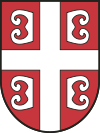 | ||||||||||||||||
|
||||||||||||||||
|
||||||||||||||||
|
||||||||||||||||
|
||||||||||||||||
|
||||||||||||||||
|
| ||||||||||||||||
In ancient geographical sources, Moesia was bounded to the south by the Balkans (Haemus) and Šar mountain (Scardus, Scordus, Scodrus) mountains, to the west by the Drina river (Drinus), on the north by the Danube and on the east by the Euxine (Black Sea). The region was inhabited chiefly by Thracian, Dacian and Illyrian peoples.
The region took its name from the Moesi, a Thraco-Dacian tribe that lived there before the Roman conquest 75 BC-c. 29 BC and formally became a Roman province of that name some years later (by 6 AD).
Cities and towns, in Moesia Superior (at times Macedonia/ Dardania):
Pannonia
The cities and towns in Pannonia, located in modern Serbia, were:
- Acumincum (Stari Slankamen)
- Bassianae (Donji Petrovci)
- Bononia (Banoštor)
- Burgenae (Novi Banovci)
- Cusum (Petrovaradin)
- Rittium (Surduk)
- Singidunum (Beograd)
- Sirmium (Sremska Mitrovica)
- Taurunum (Zemun)
Cultures and tribes
| Tribes in Roman Serbia | ||||
|---|---|---|---|---|
| Name (Group) |
Time | Territory | Notes | Sites |
| Moesi (Daco-Thracian) | 87 AD | Central Serbia | Crassus defeated them in the 29 BC, during the Wars of Augustus. They are eponymous to Moesia. | |
| Triballi (Thracian) | 87 AD | Central Serbia | mentioned first in 424 BC. They fought the Macedonians throughout the 5th and 4th century BC. They are last mentioned in 3rd century AD. | |
| Timachi (Thracian) | 87 AD | Timok | a Romanized Thracian tribe. | |
| Tricornenses (Thraco-Celtic) | 6 AD | a Romanized Thraco-Celtic tribe that governed the city of Tricornium (Ritopek) | Ritopek | |
| Picenses (Unknown) | 6 AD | governed Pincum (Veliko Gradište) | ||
| Iazyges (Sarmatians) | 92 AD | Bačka Banat | Penetrated northern Rome in late 1st century AD. | |
| Gepids (Gothic) | 375 AD | Vojvodina | a Gothic tribe in Vojvodina, Serbia. | |
See also
References
- 1 2 Andrić, Stanko (October 2002). "Southern Pannonia during the age of the Great Migrations". Scrinia Slavonica. Slavonski Brod, Croatia: Croatian Historical Institute - Department of History of Slavonia, Srijem and Baranja. 2 (1). ISSN 1332-4853. Retrieved 27 February 2012.
- ↑ Cyril Mango. Byzantium: The Empire of New Rome. Scribner's, 1980.
- ↑ http://www.arheo-amateri.rs/2012/03/17-rimskih-imperatora-rodenih-u-srbiji/ Listing provided by the archeological association of Serbia. Information also verifiable on the Emperors' wikipedia pages.
- ↑ Anica Nikolić (26 April 2008). "Profit na drumovima rimskih imperatora" [Profit on the roads of Roman emperors]. Politika (in Serbian). p. 18.
- ↑ Barnes, New Empire, p. 37.
- 1 2 3 Hupchick, Dennis P. The Balkans: From Constantinople to Communism. Palgrave Macmillan, 2004. ISBN 1-4039-6417-3
- 1 2 http://www.rastko.rs/arheologija/delo/13047
- ↑ BG III 40
- ↑ Curta (2001), pp. 91–92, 315
- ↑ History of the Later Roman Empire from Arcadius to Irene (2008)
- ↑ Cambridge Medieval Encyclopedia, Volume II.
- ↑ Curta, Florin. The Making of the Slavs. Cambridge University Press, 2001, p. 48. "Beginning in 571, John spent eight years in prison. Most of Book VI, if not the entire third part of the History, was written during this period of confinement...John was no doubt influenced by the pessimistic atmosphere at Constantinople in the 580s to overstate the intensity of Slavic ravaging."
- ↑ Curta, Florin. The Making of the Slavs. Cambridge University Press, 2001, p. 48. "On the other hand, God was on their side, for in John's eyes, they were God's instrument for punishing the persecutors of the Monophysites. This may also explain why John insists that, beginning with 581 (just ten years after Justin II started persecuting the Monophysites), the Slavs began occupying Roman territory..."
- ↑ The Roman army as a community: including papers of a conference held at ... by Adrian Keith Goldsworthy, Ian Haynes, Colin E. P. Adams, ISBN 1-887829-34-2, 1997, page 100
- ↑ The Illyrians by J. J. Wilkes, 1992, ISBN 0-631-19807-5, Page 258, "In the south the new city named municipium Dardanicum, was another 'mining town' connected with the local workings (Metalla Dardanica)."
- ↑ The central Balkan tribes in pre-Roman times: Triballi, Autariatae ... by Fanula Papazoglu, 1978, page 198, "... the Peutinger Table marks 40 miles from Naissus, on the Naissus-founded by Auielian..."
- ↑ Hauptstädte in Südosteuropa: Geschichte, Funktion, nationale Symbolkraft by Harald Heppner, page 134
Sources
- Books
- Bulić, Dejan (2013). The Fortifications of the Late Antiquity and Early Byzantine Period. The World of the Slavs: Studies of the East, West and South Slavs: Civitas, Oppidas, Villas and Archeological Evidence (7th to 11th Centuries AD). Istorijski institut. pp. 137–233. ISBN 978-86-7743-104-4.
- Curta, Florin (2001). The Making of the Slavs: History and Archaeology of the Lower Danube Region, c. 500–700. Cambridge: Cambridge University Press.
- Curta, Florin (2006). Southeastern Europe in the Middle Ages, 500–1250. Cambridge: Cambridge University Press.
- Mócsy, András (2014) [1974]. Pannonia and Upper Moesia: A History of the Middle Danube Provinces of the Roman Empire. New York: Routledge.
- Turlej, Stanisław (2016). Justiniana Prima: An Underestimated Aspect of Justinian’s Church Policy. Krakow: Jagiellonian University Press.
- Wilkes, John J. (1969). History of the Provinces of the Roman Empire. London, United Kingdom: Routledge and Kegan Paul.
- Journals
- Mirković, Miroslava (1968). "Римски градови на Дунаву у Горњој Мезији". Дисертације. Belgrade: Археолошко друштво Југославије.
- Curta, F. 2001, "Limes and cross: The religious dimension of the sixth-century Danube frontier of the Early Byzantine Empire", Starinar, no. 51, pp. 45-70.
- Kuzmanović, Zorica, and Vladimir D. Mihajlović. "Roman emperors and identity constructions in modern Serbia." Identities 22.4 (2015): 416-432.
